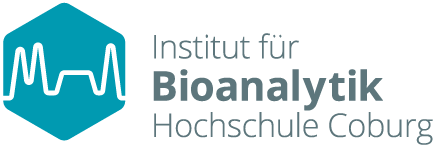Equipment:
The Institute of Bioanalysis has labs for chemical, microbiological, biochemical/molecular biology and cell culture. The microbiological lab is approved for experiments subjected security level 1 (regarding BioStoffV and GentG) and security level 2 (regarding BioStoffV). The laboratory for microbiological and biochemical/molecular biology is approved for experiments subjected security level 1 (regarding BioStoffV and GentG).
In 2018 the Institute for Bioanalysis was extended by a lab for molecular cell biology to open the possibility for cell culture experiments.
All four labs possess basic equipment including biological safety cabinets, centrifuges (refrigerated), waterbaths, shakers, incubators, and microscopes.
There are manifold opportunities for DNA-and protein analysis, for microbial experiments as well as for chemical or physical analysis and last but not least chromatographic approaches.
Techniques:
Protein-protein interaction
Phage display, biomarker development, biomarker detection, ELISA, fluorescence microscopy, identification of ligands by AP-MS and in house software PIPINO
Protein quantification
SILAC (>3000 proteins), SILAM, TMT (up to 10-plex), LFQ
Protein modification
Phosphorylation, Signal peptidase cleavage sites, sulfation
Protein structure
Chemical crosslinking, H/D exchange mass spectrometry
Antibodies
Antibody development and production, liable to GLP/GMP (Fraunhofer IZI)
Microbial communities
Characterization of phylogenetic and functional composition of microbial communities (biofilm, food stuff, biofuel, material)
Material investigation
Material resistance and colonization ability regarding microorganisms and biofilms with or without biocide
Analysis of microbial adaptation
Microbial susceptibility (to antibiotics, biocides and natural vegetable/herbal substances)
Analysis of human-pathogenic microorganisms
Culture collection of food associated pathogens, identification of pathogens, determination of microbial activity, qPCR of functional genes
Based stable-isotope probing (SIP)
Analysis of complex, metabolic processes in bacteria by fatty acid-SIP, RNA-SIP or Protein-SIP, e.g. research of biocide degradation or methanogenesis
Fluoreszenz in situ Hybridisierung (FISH)
Sequence based visualisation of microorganisms in their habitat
Cell culture
Primary cell culture
3D cell and organoid culture
Gene expression analysis
Sequencing and microarrays
siRNA and lentiviral knock down of genes for functional analysis
Fluorescence based cell staining
Flow Cytometry
Immunofluorescence staining, microscopy and image analysis
Drug discovery
Development of cell based assay systems for drug discovery and testing
Biomarker discovery
Metabolomics
Epigenetics
Analysis of epigenetic modification inhuman cells and tissues
Cell culture
Cultivation of primary human cells and cell lines, cell based assays to monitor cellular processes, 3D cellculture techniques (e.g. human skin models), transfection of cells for manipulation (e.g. siRNA, shRNA), histology andImmunofluorescence staining and microscopy, gene expression profiling (RNA-Seq, Microarrrays, qPCR), Flow Cytometry, all standard molecular biology techniques (cloning, protein analysis etc.)
Equipment
Chemical Lab
- Orbitrap Mass Spectrometer: protein identification, protein modification, quantification, proteomic analysis
- Nano HPLC: protein separation
- IR spectrometer: identification of functional groups and small molecules
- GC-MS: identification of compounds with low molecular weight
- Mobile GC: field measures of gaseous compounds
- UPLC system: separation of complex mixtures
- ICP-MS: quantitative element analysis
Microbiological und biochemical lab
- high performance flow cytometer (detecting 17 parameters)
- DNA, RNA and protein gel electrophoresis
- Incubators
- High-throughput extraction methods for RNA and DNA from complex matrices
- PCR-thermocycler: DNA and RNA amplification
- qPCR-Cycler for real-time PCR
- FLUOstar Optima Microplate Reader: e.g. fluorescence-, luminescence- detection, UV/VIS- absorbance spectra
- Photometer
- Different microscopes
- Fluorescence microscope with an digital EM-CCD-camera
- Flow cytometer
Cell Culture Lab
- CleanBench
- Incubators
- Microscope
- Casy-Counter
Contact
Institute of Bioanalysis
Faculty of Applied Sciences
Coburg University of applied Sciences and Arts
Dr. Eva-Maria Wittmann
Scientific Project Management
Phone: +49 9561 – 317 787
e-Mail: bioanalytik@hs-coburg.de

© Institut für Bioanalytik, Hochschule Coburg

